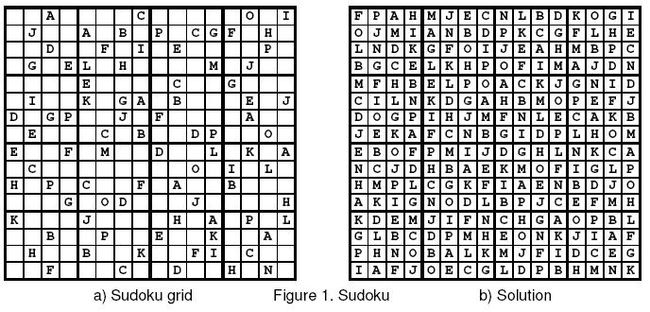POJ 3076 Sudoku DLX精确覆盖
DLX精确覆盖模版题.....
[Submit] [Go Back] [Status] [Discuss]
#include <iostream>
#include <cstdio>
#include <cstring>
#include <algorithm>
using namespace std;
const int N=16;
const int maxn=N*N*N+10;
const int maxm=N*N*4+10;
const int maxnode=maxn*4+maxm+10;
char sudoku[maxn];
struct DLX
{
int n,m,size;
int U[maxnode],D[maxnode],L[maxnode],R[maxnode],Row[maxnode],Col[maxnode];
int H[maxnode],S[maxnode];
int ansd,ans[maxn];
void init(int _n,int _m)
{
n=_n; m=_m;
for(int i=0;i<=m;i++)
{
S[i]=0;
U[i]=D[i]=i;
L[i]=i-1;
R[i]=i+1;
}
R[m]=0; L[0]=m;
size=m;
for(int i=1;i<=n;i++) H[i]=-1;
}
void Link(int r,int c)
{
++S[Col[++size]=c];
Row[size]=r;
D[size]=D[c];
U[D[c]]=size;
U[size]=c;
D[c]=size;
if(H[r]<0) H[r]=L[size]=R[size]=size;
else
{
R[size]=R[H[r]];
L[R[H[r]]]=size;
L[size]=H[r];
R[H[r]]=size;
}
}
void remove(int c)
{
L[R[c]]=L[c]; R[L[c]]=R[c];
for(int i=D[c];i!=c;i=D[i])
for(int j=R[i];j!=i;j=R[j])
{
U[D[j]]=U[j];
D[U[j]]=D[j];
--S[Col[j]];
}
}
void resume(int c)
{
for(int i=U[c];i!=c;i=U[i])
for(int j=L[i];j!=i;j=L[j])
++S[Col[U[D[j]]=D[U[j]]=j]];
L[R[c]]=R[L[c]]=c;
}
bool Dance(int d)
{
if(R[0]==0)
{
for(int i=0;i<d;i++) sudoku[(ans[i]-1)/16]=(ans[i]-1)%16+'A';
//printf("%s\n",sudoku);
for(int i=0,sz=N*N;i<sz;i++)
{
putchar(sudoku[i]);
if((i+1)%16==0) putchar(10);
}
return true;
}
int c=R[0];
for(int i=R[0];i!=0;i=R[i])
if(S[i]<S[c]) c=i;
remove(c);
for(int i=D[c];i!=c;i=D[i])
{
ans[d]=Row[i];
for(int j=R[i];j!=i;j=R[j]) remove(Col[j]);
if(Dance(d+1)) return true;
for(int j=L[i];j!=i;j=L[j]) resume(Col[j]);
}
resume(c);
return false;
}
};
DLX dlx;
void place(int& r,int& c1,int& c2,int& c3,int& c4,int i,int j,int k)
{
r=(i*N+j)*N+k;
c1=i*N+j+1;
c2=N*N+N*i+k;
c3=N*N*2+N*j+k;
c4=N*N*3+((i/4)*4+(j/4))*N+k;
}
int main()
{
while(scanf("%s",sudoku)!=EOF)
{
for(int i=1;i<16;i++)
scanf("%s",sudoku+i*16);
dlx.init(N*N*N,N*N*4);
for(int i=0;i<N;i++)
{
for(int j=0;j<N;j++)
{
for(int k=1;k<=N;k++)
{
if(sudoku[i*N+j]=='-'||sudoku[i*N+j]==k+'A'-1)
{
int r,c1,c2,c3,c4;
place(r,c1,c2,c3,c4,i,j,k);
dlx.Link(r,c1);
dlx.Link(r,c2);
dlx.Link(r,c3);
dlx.Link(r,c4);
}
}
}
}
dlx.Dance(0);
putchar(10);
}
return 0;
}
